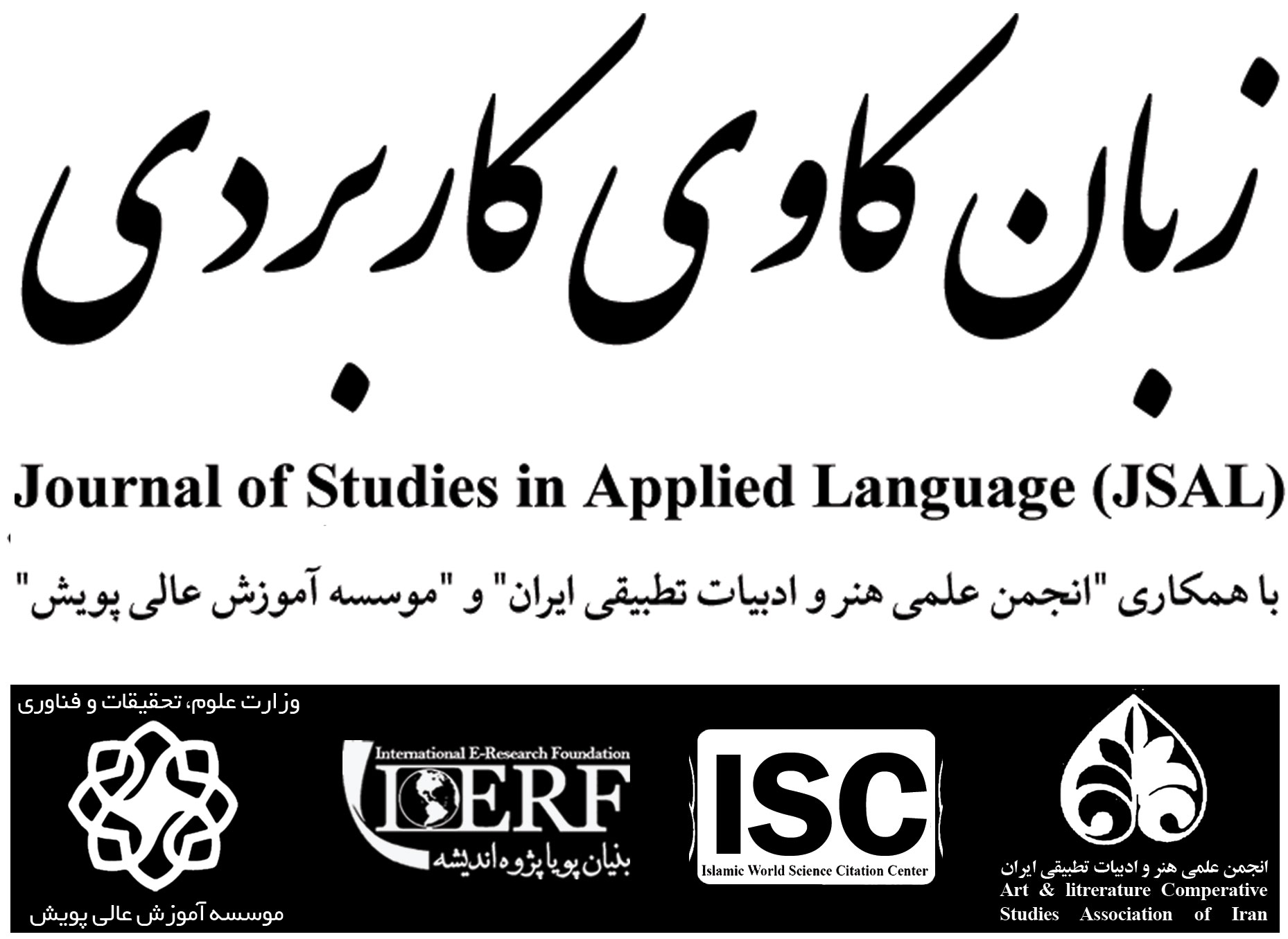دوره 6، شماره 2 - ( 2-1402 )
جلد 6 شماره 2 صفحات 15-1 |
برگشت به فهرست نسخه ها
Download citation:
BibTeX | RIS | EndNote | Medlars | ProCite | Reference Manager | RefWorks
Send citation to:



BibTeX | RIS | EndNote | Medlars | ProCite | Reference Manager | RefWorks
Send citation to:
Imani Z. (2023). A Semantic Analysis of the Verb dowr zædæn (to turn around) in Persian: A FrameNet-Based Account [In English]. JSAL. 6(2), 1-15. doi:10.52547/jsal.6.2.1
URL: http://jsal.ierf.ir/article-1-27-fa.html
URL: http://jsal.ierf.ir/article-1-27-fa.html
ایمانی زلفا.(1402). تحلیل معنایی فعل dowr zædæn در فارسی: مبتنی بر FrameNet [به انگلیسی] زبان کاوی کاربردی 6 (2) :15-1 10.52547/jsal.6.2.1
دانشجوی دکتری زبان شناسی عمومی، دانشکده زبان های خارجی، دانشگاه اصفهان ، zolfa.imani.1985@gmail.com
چکیده: (3625 مشاهده)
بررسی چارچوبهای معنایی برانگیختهشده توسط مباحث نحوی مختلف، همواره کانون مطالعه در حوزه زبانشناسی شناختی بوده است. در اینجا مبحث نحوی یک فعل است و فرضیه این است که چون فعل dowr zᴂdᴂn در فارسی یک فعل حرکتی چندمعنایی است، انتظار می رود همانطور که بین معانی آن اشتراک معانی وجود دارد، یک همبستگی نیز وجود داشته باشد. رابطه میان چارچوب های معنایی برانگیخته شده در آن، که در موقعیت های مختلف استفاده از فعل تشکیل شده است، در مرحله اول از مجموعه ای استخراج شده سپس موارد تکراری حذف می شود تا از هر موقعیت فقط یک نوع باقی بماند. پس از ترجمه به انگلیسی و جستجو از طریق پایگاه داده FrameNet، موارد فارسی در کنار قالب آنها مقایسه و مورد تجزیه و تحلیل قرار می گیرد. در نتیجه مشخص می شود یک ارتباط معنایی بین قالبهای معنایی وجود دارد که حرکت چندمعنایی مورد بحث - چرخش مدور یا انحراف از مسیر اصلی - ایجاد میکند.
نوع مطالعه: پژوهشي |
موضوع مقاله:
زبان شناسی اجتماعی
دریافت: 1400/1/1 | پذیرش: 1401/3/12 | انتشار: 1402/2/2
دریافت: 1400/1/1 | پذیرش: 1401/3/12 | انتشار: 1402/2/2
فهرست منابع
1. Ardeshir Jey, Sh. (1959). A dictionary of Persian-English idioms. 3th edition. Tehran: Tehran University Press.
2. Aryanpur, A. & Aryanpur, M. (2008). The pocket Persian English dictionary. Teheran: Amir Kabir Publishing Institute.
3. Aryanpur, M. (2007). The Aryanpur progressive Persian-English dictionary: One volume, mini companion. Tehran: Jahan Rayaneh Publishing.
4. Baker, C. F. & Ruppenhofer, J. (2002). Framenet's frames vs. Levin's verb classes. Computer Science. [DOI:10.3765/bls.v28i1.3816]
5. Baker, Collin F., Fillmore, C. J. & Lowe, J. B. (1998). The Berkeley FrameNet project. Proceedings of the 17th International Conferenvce on Computational Linguistics. Vol. 1, pp. 86-90. [DOI:10.3115/980451.980860]
6. Cristobal, M. (2001). "Arriving Events in English and Spanish: A Contrastive Analysis in terms of Frame Semantics". International Computer Science Institute Technical Reports, Estudios de lingüística del español, Vol. 31, pp 01-09.
7. Dekova, R. & Nestorova, P. I. (2008). Verbs of movement in the Bulgarian FrameNet. In Papanikos, G. T. (Ed.) Literature, Language & Linguistics.
8. Fillmore, C. J. (1977a). "The case for case reopened". In P. Cole, & J. Sadock, Syntax and Semantics 8: Grammatical Relations, New York: Academic Press, pp. 59-81. Doi: 10.1163/9789004368866_005 [DOI:10.1163/9789004368866_005]
9. Fillmore, C. J. (1977b). "Scenes and frames semantics". In A. Zampolli, Linguistic Structures Processing. Fundamental Studies in Computer Science, Amesterdam: North Holland, Vol. 5, pp. 55-81.
10. Fillmore, C. J. (1977c). Topics in lexical semantics. In R. W. Cole, Current Issues in Linguistic Theory. Bloomington: Indiana University Press.
11. Fillmore, C. J. (1982). "Frame semantics". The Linguistic Society of Korea: Linguistic in the Morning Calm, pp. 65-173.
12. Fillmore, C. J. (1985). "Frames and the semantics of understanding". Quaderni di Semantica, No. 6, pp. 222-254.
13. Fillmore, C. J. (2006). "Frame semantics". In K. Allan, Concise Encyclopedia of Semantics, Oxford/ Amesterdam. Elsevier, pp. 613-620. [DOI:10.1016/B0-08-044854-2/00424-7]
14. Ghaffari, S. (2007). Aborz two-way companion dictionary: English-Persian & Persian-English. Tehran: Asim Press.
15. Hamedi Shirvan Z, Sharifi S. (2014) "A Typological Analysis of Satellite in the Event Structure of Motion Verbs in Persian", LRR, Vol. 5, No. 2, pp. 71-89.
16. Imani, Z. & Motavallian, R. (2020a). "Motion verbs of manner in FrameNet: A comparison between Persian and English." Kervan, Vol. 24, No. 1, pp. 107-122. Doi: 10.13135/1825-263X/4106
17. Imani, Z. & Motavallian, R. (2020b). "he Study of Semantic Frames and the Way of Expressing Direction in Persian Motion Verbs: Case of "Come" and "Go"". Journal of Western Iranian Languages and Dialects, Vol. 8, No, 3, pp. 1-11. Doi: 10.22126/jlw.2020.4754.1380.
18. Imani, Z. & Motavallian, R. (2020c). "Motion verbs in Persian and English: A FrameNet-based contrastive analysis." Facta Universitatis: Linguistics and Literature, Vol. 18, No. 2, pp. 195-205. Doi: 10.22190/FULL2002195I [DOI:10.22190/FULL2002195I]
19. Levin, B. (1993). English verb classes and alternation: a preliminary investigation. Chicago: The University of Chicago Press.
20. Nazari Teimoori, E. (2005). A dictionary of proverbs and colloquial idioms. 3th edition. Tehran: Yadvareh Ketab Publishing.
21. Petruck, M. R. L. (1997). "Framing motion in Hebrew and English". In R. Rossini Favretti (ed.), FramesCorpora and Knowledge Representation. Bologna: Bologna UniversityPress, pp. 43-51.
22. Talmy, L. (1972). Semantic Structures in English and Atsugewi. Doctoral dissertation, University of Clifornia, Berkeley.
23. Talmy, L. (1985). Lexicalization Patterns: Semantic Structure in Lexical Forms, in T. Shopen (ed.) Language Typology and Syntactic Description 3, Cambridge University Press.
24. Talmy, L. (2000a). Toward a cognitive semantics. Vol. II. Cambridge: MIT Press. [DOI:10.7551/mitpress/6847.001.0001]
25. Talmy, L.(2000b). Toward a cognitive semantics. Vol. II. Cambridge: MIT Press. [DOI:10.7551/mitpress/6847.001.0001]
ارسال پیام به نویسنده مسئول
| بازنشر اطلاعات | |
 |
این مقاله تحت شرایط Creative Commons Attribution-NonCommercial 4.0 International License قابل بازنشر است. |








